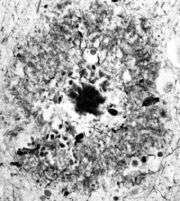Researchers seeking to identify Alzheimer's risk focus on specific blood biomarker

A simple blood test to detect whether a person might develop Alzheimer's disease is within sight and could eventually help scientists in their quest toward reversing the disease's onset in those likely to develop the debilitating neurological condition.
Building on a study that started 20 years ago with an elderly population in Northern Manhattan at risk or in various stages of developing Alzheimer's disease, the Columbia research group has yielded ground-breaking findings that could change the way the disease is treated or someday prevent it. These findings suggest that by looking at the blood doctors may be able to detect a person's predisposition to developing the dementia-inducing disease that robs a person of their memory and ability carry out tasks essential to life.
Results presented online in the Proceedings of the National Academy of Sciences during the week of Sept. 8, 2008 suggest that individuals with elevated levels of a certain peptide in the blood plasma, Amyloid Beta 42 (Aß42), are at increased risk of developing Alzheimer's disease and that the decline of Aß42 in the bloodstream may reflect the compartmentalization or "traffic jam" of Aß42 in the brain, which occurs in the brain's of people with Alzheimer's.
"To date, Aß42 levels have measured most reliably in the cerebrospinal fluid, which is more difficult to collect than blood," said Nicole Schupf, Ph.D., Dr.P.H., associate professor of clinical epidemiology at Columbia University Medical Center and lead author of the paper. "Blood draws can be done with relative ease and greater frequency than spinal taps, which is typically the way cerebrospinal fluid is collected."
In this study, researchers found that plasma levels of Aß42 appear to increase before the onset of Alzheimer's disease and decline shortly after the onset of dementia. Researchers surmise that Aß42 may become trapped in the brain, which could account for the decrease in levels post-dementia.
The principal investigator on the Northern Manhattan study, Richard Mayeux, M.D., M.S., professor of neurology, psychiatry, and epidemiology, and co-director of the Taub Institute of Research on Alzheimer's Disease and the Aging Brain at CUMC, likens the finding to something similar that is seen in heart attack patients, who typically have elevated lipid levels in their bloodstream prior to a heart attack, but post-heart attack lipid levels may decrease.
Using more specific antibodies developed by the Ravetch Laboratory at Rockefeller University, the researchers were able to hone in on the most detrimental form of amyloid compound, the protofibrillar form of Aß, according to Dr. Mayeux, who is the senior author of this paper.
While the cognitive impairments of Alzheimer's can be monitored throughout the disease course, clinicians have had no reliable way to monitor the pathologic progression of the disease. Being able to reliably measure Aß levels in the blood could provide clinicians with a tool that forecasts the onset of Alzheimer's much earlier. Earlier detection would of course be an important step in combating the disease, researchers said.
Source: Columbia University Medical Center




















